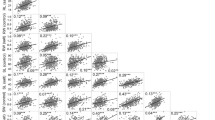Abstract
The genetic basis of salt tolerance was examined in selected salt tolerant and sensitive material from a sample of accessions previously assessed for variability in salinity tolerance. The North Carolina Model 2 Design and analysis was followed, tolerance being assessed in 10-day-old seedlings grown in salinized solution culture at control (0 mM), 60 mM and 80 mM NaCl concentrations). Salinity tolerance was shown to be under the control of genes with additive and non-additive effects, with broad and narrow sense heritability estimates being approximately 0.7 and 0.4 over all treatments.
Similar content being viewed by others
References
Abel, G.M., 1969. Inheritance of the capacity for chloride inclusion and chloride exclusion by soybean. Crop Sci 9: 697–698.
Ahsan, M., D. Wright & D. Vrik, 1996. Genetic analysis of salt tolerance in spring wheat (Triticum aestivum L.). Cereal Research Communication 24(3): 353–360.
Akbar, M. & T. Yabuno, 1977. Breeding saline resistance varieties of rice. IV. Inheritance of delayed type panicle sterility induced by salinity. Japan J Breed 27: 237–240.
Al-Khatib, M., T. McNeilly & J.C. Collins, 1993. The potential for selection and breeding for improved salt tolerance in lucerne (Medicago sativa L.). Euphytica 65: 43–51.
Al-Khatib, M., T. McNeilly & J.C. Collins, 1994. The genetic basis of salt tolerance in Lucerne (Medicago sativa L.). J Genet & Breed 48: 169–174.
Ashraf, M. & T. McNeilly, 1989. Effect of salinity on some cultivars of maize. Maydica 34: 179–189.
Ashraf, M. & T. McNeilly, 1990. Improvement of salt tolerance in maize by selection and breeding. Plant Breed 104(2): 101–107.
Ashraf, M., T. McNeilly & A.D. Bradshaw, 1986. The potential for evolution of salt tolerance in seven grass species. New Phytol 103: 299–309.
Azhar, F.M. & T. McNeilly, 1988. The genetic basis of variation for salt tolerance in Sorghum bicolor (L.) Moench, seedlings. Plant Breed 101: 114–121.
Azhar, F.M. & T. McNeilly, 1989. The response of four sorghum accessions/cultivars to salinity during whole plant development. J Agron and Crop Sci 163: 33–43.
Becker, W.A., 1992. Manual of Quantitative Genetics. 5th ed. Academic Enterprises, Pullman, WA.
Bernstein, L. & H.E. Hayward, 1958. Physiology of salt tolerance. Ann Rev Plant Physiol 9: 25–46.
Blum, A., 1988. Plant breeding for stress environment. CRC Pres Inc Boca Raton, Florida.
Comstock, R.E. & H.F. Robinson, 1952. Estimation of average dominance of genes. Heterosis, Ch 30 Iowa State College Press.
Dewey, D.R., 1960. Salt tolerance of twenty five strains of Agropyron. Agron J 52: 631–635.
Epstein, E. & J.D. Norly, 1977. Sea-water based crop production: A feasibility study. Science 197: 249–251.
Epstein, E., J. D. Norlyn, D.W. Rush, R.W. Kingsbury, D.W. Kelley, G.A. Cunningham & A.F. Wrona, 1980. Saline culture of crops: A genetic approach. Science 210: 399–404.
Falconer, D.S. & T.F.C. MacKay, 1996. Introduction to quantitative genetics. Chapman and Hall, London.
Gregorio, G.B. & D. Senadhira, 1993. Genetic analysis of salinity tolerance in rice (Oryza sativa L.). Theor Appl Genet 86: 333–338.
Hewitt, E.J., 1966. Sand and water culture methods used in the study of plant nutrition. Commonwealth Agriculture Bureaux. Technical Communication. No. 22.
Hoffman, A.A. & P.A. Parsons, 1991. Evolutionary Genetics and Environmental Stress. Oxford Uni Press, New York.
Jinks, J.L., J.M. Perkins & H.S. Pooni, 1973. The incidence of epistasis in normal and extreme environments. Heredity 31: 263–269.
Kacser, H. & J.A. Burns, 1981. The molecular basis of dominance. Genetics 97: 639–666.
Kebebew, F., 1994. The potential for improving salt tolerance in minor millets, Pennisetum americanum (L.) Leeke (Pearl Millet) and Eleusine coracana (L.) Gaertn. (Finger Millet), and Eragrostis tef (Zucc.) Trotter (Tef). PhD Thesis University of Liverpool.
Kebebew, F. & T. McNeilly, 1996. The genetic basis of variation in salt tolerance in Pearl Millet, Pennisetum americanum (L.) Leeke. J Genet and Breed 50: 129–136.
Lawrence, M.J., 1984. The genetical analysis of ecological traits. In: B. Shorrocks (Ed), Evolutionarity ecology, Blackwell Sci Publ Oxford, London, Edinburgh, pp. 27–63.
Maiti, R.K., L.E.D. Amaya, S.I. Cardona, A.M.O. Dimas, M. Dela Rosa-Ibarra & H.D.L. Castillo, 1996. Genotype variability in maize cultivars (Zea mays) for resistance to drought and salinity. J Plant Physiol 148: 741–744.
Mather, K., 1973. Genetic structure of populations. Chapman and Hall, London.
Mather, K. & J.L. Jinks, 1971. Biometrical genetics. The study of continuous variation. Chapman and Hall, London.
Moeljopawiro, S. & H. Ikehashi, 1981. Inheritance of salt tolerance in rice. Euphytica 30: 291–300.
Noble, C.L., G.M. Halloran & D.W. West, 1984. Identification and selection for salt tolerance in Lucerne (Medicago sativa L.). Aust J Agri Res 35: 239–252.
Rao, S.A., 1997. The potential for breeding Zea mays L. for saline conditions. PhD Thesis. The University of Liverpool, U.K.
Richards, R.A., 1978. Genetic analysis of drought stress response in rape seed (Brassica compestris and B. napus). I. Assessment of environments for maximum selection response in grain yield. Euphytica 27: 609–615.
Rumbaugh, M.D., K.H. Asay & D.A. Johnson, 1984. Influence of drought stress on genetic variance of alfalfa and wheat grass seedling. Crop Sci 24: 297–303.
Shannon, M.C., 1984. Breeding, selection, and the genetics of salt tolerance. In: R.C. Staples & G.H. Toenniessen (Eds), Salinity Tolerance in Plants-Strategies for Crop Improvement, pp. 231–254. Wiley-Interscience Publication, New York, Chichester, Brisbane, Toronto, Singapore.
Shannon, M.C., 1985. Principles and strategies in breeding for salt tolerance. Plant and Soil 89: 227–281.
SPSS, 1994. Repeated Measure Analysis of Variance, pp. 107–143. In SPSS Advance Statistics. Release 6.1.
Tal, M., 1985. Genetics of salt tolerance in higher plants: Theoretical and practical considerations. Plant and Soil 89: 199–226.
Author information
Authors and Affiliations
Rights and permissions
About this article
Cite this article
Rao, S.A., McNeilly, T. Genetic basis of variation for salt tolerance in maize ( Zea mays L).. Euphytica 108, 145–150 (1999). https://doi.org/10.1023/A:1003612411293
Issue Date:
DOI: https://doi.org/10.1023/A:1003612411293




